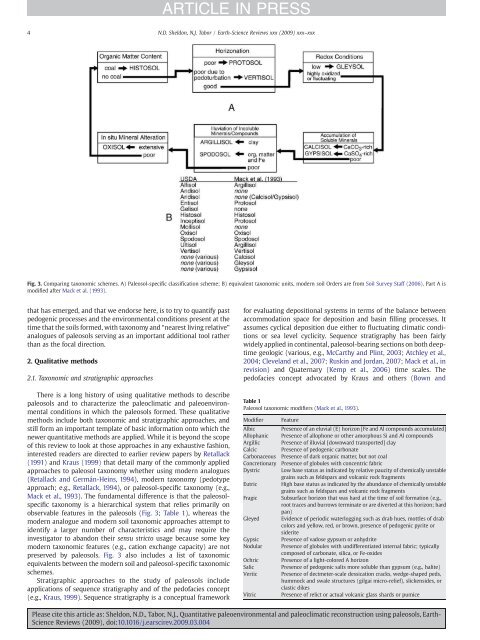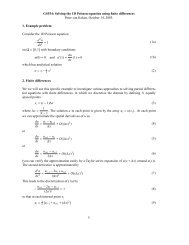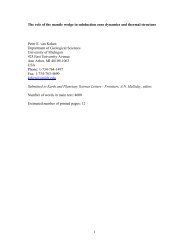Quantitative paleoenvironmental and paleoclimatic reconstruction ...
Quantitative paleoenvironmental and paleoclimatic reconstruction ...
Quantitative paleoenvironmental and paleoclimatic reconstruction ...
Create successful ePaper yourself
Turn your PDF publications into a flip-book with our unique Google optimized e-Paper software.
ARTICLE IN PRESS<br />
4 N.D. Sheldon, N.J. Tabor / Earth-Science Reviews xxx (2009) xxx–xxx<br />
Fig. 3. Comparing taxonomic schemes. A) Paleosol-specific classification scheme; B) equivalent taxonomic units, modern soil Orders are from Soil Survey Staff (2006). Part A is<br />
modified after Mack et al. (1993).<br />
that has emerged, <strong>and</strong> that we endorse here, is to try to quantify past<br />
pedogenic processes <strong>and</strong> the environmental conditions present at the<br />
time that the soils formed, with taxonomy <strong>and</strong> “nearest living relative”<br />
analogues of paleosols serving as an important additional tool rather<br />
than as the focal direction.<br />
2. Qualitative methods<br />
2.1. Taxonomic <strong>and</strong> stratigraphic approaches<br />
There is a long history of using qualitative methods to describe<br />
paleosols <strong>and</strong> to characterize the <strong>paleoclimatic</strong> <strong>and</strong> <strong>paleoenvironmental</strong><br />
conditions in which the paleosols formed. These qualitative<br />
methods include both taxonomic <strong>and</strong> stratigraphic approaches, <strong>and</strong><br />
still form an important template of basic information onto which the<br />
newer quantitative methods are applied. While it is beyond the scope<br />
of this review to look at those approaches in any exhaustive fashion,<br />
interested readers are directed to earlier review papers by Retallack<br />
(1991) <strong>and</strong> Kraus (1999) that detail many of the commonly applied<br />
approaches to paleosol taxonomy whether using modern analogues<br />
(Retallack <strong>and</strong> Germán-Heins, 1994), modern taxonomy (pedotype<br />
approach; e.g., Retallack, 1994), or paleosol-specific taxonomy (e.g.,<br />
Mack et al., 1993). The fundamental difference is that the paleosolspecific<br />
taxonomy is a hierarchical system that relies primarily on<br />
observable features in the paleosols (Fig. 3; Table 1), whereas the<br />
modern analogue <strong>and</strong> modern soil taxonomic approaches attempt to<br />
identify a larger number of characteristics <strong>and</strong> may require the<br />
investigator to ab<strong>and</strong>on their sensu stricto usage because some key<br />
modern taxonomic features (e.g., cation exchange capacity) are not<br />
preserved by paleosols. Fig. 3 also includes a list of taxonomic<br />
equivalents between the modern soil <strong>and</strong> paleosol-specific taxonomic<br />
schemes.<br />
Stratigraphic approaches to the study of paleosols include<br />
applications of sequence stratigraphy <strong>and</strong> of the pedofacies concept<br />
(e.g., Kraus, 1999). Sequence stratigraphy is a conceptual framework<br />
for evaluating depositional systems in terms of the balance between<br />
accommodation space for deposition <strong>and</strong> basin filling processes. It<br />
assumes cyclical deposition due either to fluctuating climatic conditions<br />
or sea level cyclicity. Sequence stratigraphy has been fairly<br />
widely applied in continental, paleosol-bearing sections on both deeptime<br />
geologic (various, e.g., McCarthy <strong>and</strong> Plint, 2003; Atchley et al.,<br />
2004; Clevel<strong>and</strong> et al., 2007; Ruskin <strong>and</strong> Jordan, 2007; Mack et al., in<br />
revision) <strong>and</strong> Quaternary (Kemp et al., 2006) time scales. The<br />
pedofacies concept advocated by Kraus <strong>and</strong> others (Bown <strong>and</strong><br />
Table 1<br />
Paleosol taxonomic modifiers (Mack et al., 1993).<br />
Modifier Feature<br />
Albic<br />
Presence of an eluvial (E) horizon [Fe <strong>and</strong> Al compounds accumulated]<br />
Allophanic Presence of allophone or other amorphous Si <strong>and</strong> Al compounds<br />
Argillic Presence of illuvial [downward transported] clay<br />
Calcic Presence of pedogenic carbonate<br />
Carbonaceous Presence of dark organic matter, but not coal<br />
Concretionary Presence of globules with concentric fabric<br />
Dystric Low base status as indicated by relative paucity of chemically unstable<br />
grains such as feldspars <strong>and</strong> volcanic rock fragments<br />
Eutric High base status as indicated by the abundance of chemically unstable<br />
grains such as feldspars <strong>and</strong> volcanic rock fragments<br />
Fragic Subsurface horizon that was hard at the time of soil formation (e.g.,<br />
root traces <strong>and</strong> burrows terminate or are diverted at this horizon; hard<br />
pan)<br />
Gleyed Evidence of periodic waterlogging such as drab hues, mottles of drab<br />
colors <strong>and</strong> yellow, red, or brown, presence of pedogenic pyrite or<br />
siderite<br />
Gypsic Presence of vadose gypsum or anhydrite<br />
Nodular Presence of globules with undifferentiated internal fabric; typically<br />
composed of carbonate, silica, or Fe-oxides<br />
Ochric Presence of a light-colored A horizon<br />
Salic<br />
Presence of pedogenic salts more soluble than gypsum (e.g., halite)<br />
Vertic Presence of decimeter-scale dessication cracks, wedge-shaped peds,<br />
hummock <strong>and</strong> swale structures (gilgai micro-relief), slickensides, or<br />
clastic dikes<br />
Vitric Presence of relict or actual volcanic glass shards or pumice<br />
Please cite this article as: Sheldon, N.D., Tabor, N.J., <strong>Quantitative</strong> <strong>paleoenvironmental</strong> <strong>and</strong> <strong>paleoclimatic</strong> <strong>reconstruction</strong> using paleosols, Earth-<br />
Science Reviews (2009), doi:10.1016/j.earscirev.2009.03.004















